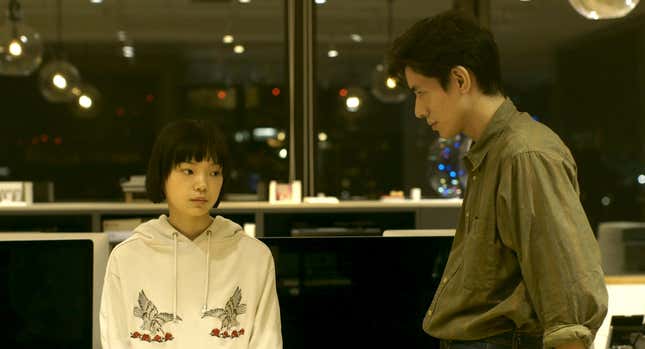
Wheel Of Fortune And Fantasy, the first of two films Japanese director Ryusuke Hamaguchi premiered this year, consists of three narratively disconnected but thematically linked episodes. Each segment runs roughly 40 minutes, follows the fallout of some romantic entanglement, and—as the title suggests—involves some crucial element of chance and coincidence. Compared to Hamaguchi’s other new movie—the three-hour Cannes prizewinner Drive My Car—this one is undeniably more modest in scale. (Some have even compared it to the work of Hong Sang-soo.) Nonetheless, in terms of conceptual ambition and formal adventurousness, Wheel Of Fortune is every bit the equal of Drive My Car. It’s also arguably the most concerted expression of Hamaguchi’s artistic preoccupations to date.
The first story, “Magic (Or Something Less Assuring),” establishes how the film plays, visually and thematically, with fantasy and appearance. After a fashion shoot, two friends, Meiko (Kotone Furukawa) and Tsugumi (Hyunri), share a taxi ride home, during which the latter tells of an amazing date she went on with a man who opened up to her about an unfaithful ex. Unfolding mostly in a single take, the scene moves with a relaxed rhythm, as Tsugumi’s evident attraction to the man blossoms into hopes of a future relationship. But as one might expect from the director of Asako I & II, surfaces prove deceptive. After dropping off Tsugumi at her apartment, Meiko turns the car around and pays a surprise visit to her ex-boyfriend, Kazuaki (Ayumu Nakajima), who turns out to be Tsugumi’s dream date. What develops from there isn’t a love triangle so much as a kind of score-settling duel between Meiko and Kazuaki—one whose resolution is anything but predictable.
With its hairpin plot turns and focus on the vagaries of romantic desire, the episode recalls the work of French New Wave director Éric Rohmer, whom Hamaguchi has repeatedly cited as an inspiration. (The point of reference in this case would be Rohmer’s 1995 urban triptych Rendez-vous In Paris.) Still, the two filmmakers’ affinities are more thematic than stylistic. Unlike Rohmer, Hamaguchi does not strive towards a consistent realism of sound and image; his formal choices and his direction of actors give the occasional impression that he’s dealing less with characters than with ideas.
Sometimes, Hamaguchi’s approach can be more conceptually daring than dramatically convincing. Wheel’s second segment, “Door Wide Open,” is a little studied and schematic. It follows Nao (Katsuki Mori), a housewife belatedly completing her university degree, who gets roped into a honey trap plot devised by her college-age lover (Shouma Kai). The target is a severe professor (Kiyohiko Shibukawa) who has just written an award-winning novel, and the episode’s centerpiece scene involves Nao reading him a long, sexually explicit section from it during his office hours. The decision to effectively halt the story in its tracks with this passage is certainly bold, but the impression it leaves—particularly after a limp coda—is of a strong idea only lightly sketched in.

Fortunately, the third episode, titled “Once Again,” closes Wheel Of Fortune on a strong note. The only segment shot after the pandemic broke, it unfolds in a world where a global computer virus has destroyed the possibility of private computer correspondence. As the episode’s scrolling opening text informs us: “The world went off-line and returned to postal mail and telegraphs.”
In the wake of this tech-apocalypse, a Tokyo-based IT specialist, Moka (Fusako Urabe), returns to her hometown for a 20-year high school reunion, evidently looking for someone—possibly an ex-girlfriend—who doesn’t turn up. The next day, on her way to the local train station, she unexpectedly catches sight of the person she was hoping to see. The woman, Nana (Aoba Kawai), recognizes Moka in turn, and invites her back to her home. But again, as one might expect by this point in Wheel, the basic setup is not as it seems.
The specific plot complications are best left for discovery, but suffice to say the episode extends Hamaguchi’s interest in the complex ways that the past comes to haunt us. Like Asako I & II, “Once Again” dramatizes what happens when our desires and fantasies go out of sync with reality. The roles we play for each other, not to mention for ourselves, and how these interact with the caprices of fate—these are the prime concerns of Wheel Of Fortune And Fantasy. Seen in this light, Hamaguchi’s deliberate disruptions of narrative flow are not crude storytelling gestures so much as attempts to create epiphanic moments out of time, where the rift between imagination and reality ceases to exist—at least until the wheel of fortune turns round once more.